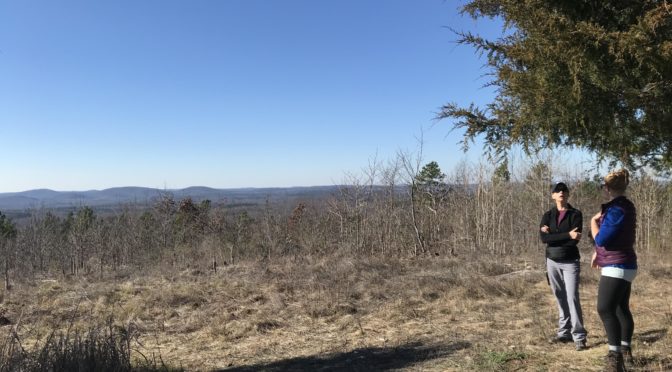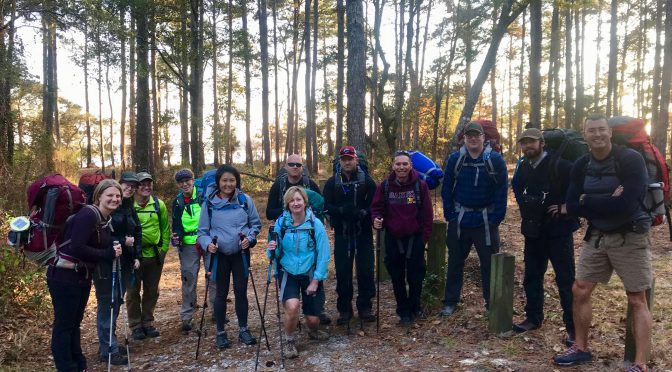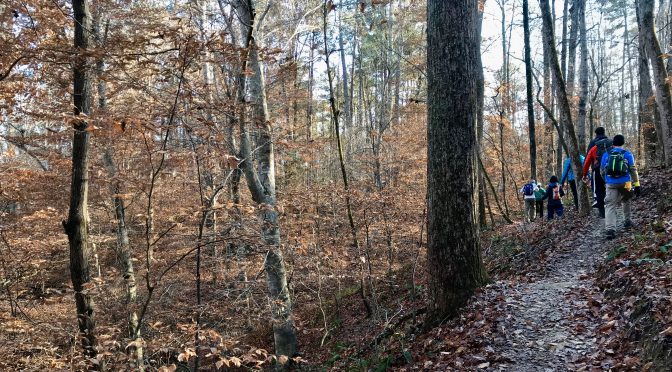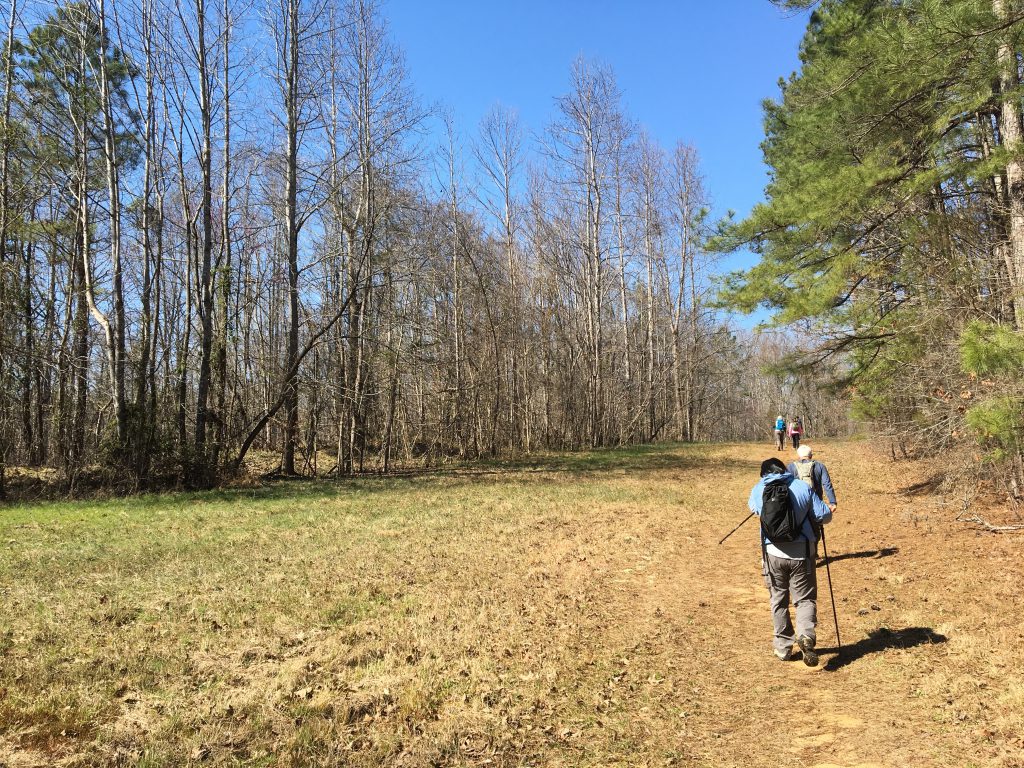Today we revisit a topic we first wrote in 2012: 10 of our favorite winter hikes. Hikes that, for various reasons, are especially good hiked in cold weather. For some (at the coast, for instance, it’s the only time you can hike them, lest you have an immunity to squadrons of dive-bombing mosquitoes and an unusually high tolerance for things that slither. For others, it may be a view otherwise obscured by a lush, full forest, or for the opportunity to hike in evergreen conditions, or because of exposed terrain that lets winter’s warming sun shine in. IMPORTANT NOTE: For mountain hikes especially check to make sure the trail is open; many mountain hikes remain closed as a result of Hurricane Helene.
Tag Archives: cold
Layer up and Get OuT
On Saturday morning’s GetHiking! hike at Umstead State Park, half the number of hikers who signed up showed up. No mystery there: it was cold.
What is a mystery is why so many hikers let a little thing like freezing temperatures keep them off the trail. As we may have mentioned (just last week, in fact), we love a winter hike: among other things, there are fewer people, fewer bugs, and it’s blissfully quiet. Yet too many people miss out because they don’t know how to dress. Let’s solve that problem here and now.
Warm up to the Cold
“I could stand it a little colder,” Jenny said as we took a short break hiking the Buckquarter Creek Trail at Eno River State Park, our first GetHiking! Winter Program for Beginners hike. Her fellow sun-drenched hikers nodded.
Now, I love hiking in winter: I love throwing on layers, then peeling them off as I warm up; I love seeing my breath; I love steam pouring off my head when pull off my wool cap. But I was surprised that so many people new to hiking were ready for more of a nip in the air. I associate new hikers with spring and its allure of wildflowers and touch of warmth, and fall, for its color and retreat from summer’s stifling heat. And so it was wonderful to see that they are ready to embrace winter’s subtle charms. Here in the Southeast, especially, winter offers these delights:
=&0=&. Here’s a paradox: It’s the coldest time of the year, yet the time when we’re nearest the sun. On a cloudless day, the sun is more brilliant than it is in July. And in a forest without leaves, you can appreciate the sun’s brilliance all the more. During the week, you go into work as the sun is coming up and you go home around the time it sets, so the weekend allows for full appreciation of this burst of sunlight.
=&1=&. It’s quiet — and it’s not. In winter there’s less wildlife chatter, fewer noisy people in the woods. And while hibernation isn’t a practice in these parts, there’s less foraging going on. The noise you can is hear from a distance, because dry winter air acts as a transmitter that’s especially effective in the absence of sound-muffling leaves. Stand still and just listen.
=&2=&. On Sunday’s hike, we followed a ridge above the Eno for three-quarters of a mile. In summer, you have no idea there’s a river below. On Sunday, we stood and watched the rain-swollen Eno course its way through a series of boulder fields, and listened to the dull roar of a river made too big for its banks. The elevated vantage point was almost better than walking along the banks.
=&3=&. In summer, we stick to the trail because who knows what lurks beyond: slithery creatures on the other side of a log, poisonous vines concealed in an ankle-high carpet of green. In winter, there are few surprises. For one, those slithery creatures aren’t likely to be out until the temperature climbs into the upper 60s and those itch-inducing leaves are in remission (though keep an eye out for fuzzy vines curling up tree trunks). The winter woods are open, the threats are minimal.
=&4=&. There are few, reason enough to love winter in the woods.
=&5=&. Winter gets a bad rap because it’s viewed as down time. This is especially true if you’ve migrated to the Southeast from the North or Midwest and are used to winter starting in mid-November and lingering through March. But here, winter soon reveals harbingers of spring. In late January, the first warm rain of the season queues a chorus of spring peepers. In early February, the woods start sprouting their first clusters of daffodils, a hardy ornamental planted by early homesteaders to brighten their lives. Then, in mid- to late-February come pairs of mottled green leaves poking through the leaf litter that soon give way to the delicate yellow and purple petals of the trout lily.
It may only be the second week of January, and just the third week of winter, but already, before the first peeper has spoken, we’re already getting nostalgic for the cold. Enjoy it while you can.
Happy trails,
Joe
Let us help you enjoy the season!
For a rundown of our winter hiking (and backpacking) programs, go here.
For our weekly GetHiking! hikes in North Carolina and Virginia, go here.
Don’t let the cold clip your hiking wings
We love hiking this time of year. The air is typically dry, the diminished foliage lets you see deeper into the woods, the slanted winter sunlight seems to light the forest from the ground up.
Yes, it’s cold, and maybe some of you shy away from hiking in the cold. But you don’t have to give up stretching your legs in the woods just because there’s a nip in the air.
Here are some tips to get you into the woods, no matter the temperature.
A forecast blown
A clear, crisp sky. Cold, invigorating air. Perfect weather for a hike. Especially for first-timers eager for a good first impression. Sunday afternoon’s weather couldn’t have been better.
Unfortunately.
* * *
I first heard of the prospect of snow from an unlikely source on Ninth Street in Durham. It was wrapped in a solicitation that seemed more far-fetched than usual. Not impossible for early March, but unlikely based on the unseasonably warm winter we’d been having. Two days later I received a text from my wife: it was a screen shot of the 7-day forecast. “Look at Sunday!” she implored. She never uses exclamation points. Sure enough, Sunday was pictographically represented by a snowflake.
As a hike leader and organizer, that set into motion my Unpleasant Weather Preparedness Plan. For the next three days, I would check the forecast first thing in the morning, at mid-afternoon, in the evening. Every time, the forecast was different. Each time, it came with the disclaimer that different forecasting models suggested different scenarios: maybe snow, maybe rain, maybe sleet.
Maybe … nothing.
* * *
For the most park, I love the unpredictability of the weather. I love having to consider the various eventualities and preparing accordingly. Packing rain gear on even the sunniest summer day in the mountains, estimating the proper fleece for a winter hike. Gloves? Hat? Gaiters? Gearing up for the journey is part of the journey itself. When it comes to hiking, about the only thing that will give me pause is an electrical storm. Years ago I was caught in an electrical storm above 12,000 feet on Engineer Pass in southwestern Colorado’s San Juan Mountains: we could actually see lightening emanate from clouds below us. Never again.
Otherwise, there’s nothing like being properly geared for a little weather — when I’m on my own. When I’m leading others, and responsible for their safety, it’s another matter. Not everyone has the proper gear for different weather occasions. Not everyone has a tolerance for getting a little wet. Not everyone would just about always be outside instead of in.
The latter is one of my main goals leading hikes, to make people want to return outside, often, and to different locales. To make that happen, though, they need to first feel comfortable. Sunday’s hike was the first in an eight-week spring series that included a lot of first-timers. More to the point, it included a lot of families: the kids have a good time, the family will be back. If they’re wet and cold, it’s six more weeks (at least) of the Xbox.
So I monitored the weather closely Wednesday, Thursday, Friday. Friday, before all my weekend hikes, I always send a reminder notice with an update on the forecast. If the weather looks iffy, I advise that they will receive word at least three hours in advance if the hike is canceled.
For Sunday’s hike, though, I deviated from standard procedure. The forecast was leaning away from accumulations of snow; worse, though, it was teetering toward icy, wet rain. Even if the trail was OK, the roads getting there might not be. So, because it was the first hike of the session (and first impressions are crucial, remember), because there were so many newbies, and because the hike was in the Triangle’s northern snow belt (Horton Grove Nature Preserve in northern Durham County), I pulled the plug early. To the hikers, I wrote, “we’re going to postpone the start of the Spring Sunday Afternoon Hiking Season until Sunday, March 19. We’ll still start at Horton Grove; we’ll move the schedule back a week … .”
* * *
Two hikers responded immediately: “Good call,” they wrote. I check the forecast late Friday afternoon: it was looking colder and wetter. I felt good about call. Until Saturday morning.
“So much for the winter weather,” a hiker on another hike I was leading said when I arrived.
Pardon?
Overnight, what wet winter weather that had been expected now wouldn’t be expected until Monday — if at all. Sunday morning arrived with the lightest of light snow, the perfect forest accent for a winter hike. By 10:30, the sun was peeking out; by noon the sky was more blue than not. By 1:30, hike time, the sky was crisp, clear, the air cold and invigorating.
Perfect weather for a hike. A hike, say, for first-timers eager for a good first impression. Yup, Sunday afternoon’s weather couldn’t have been better.
Unfortunately.




